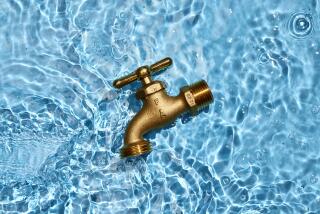INSIDE & OUT : When Water Gets Rusty, Check Pipes for Trouble
Q. We have a problem with rust coming out of our bathroom hot-water faucets. Initially, the water is rust-colored; after it becomes clear, there’s a metallic odor. The house and the fixtures are about 11 years old. What could be causing this?
T.I., Anaheim
A. There are a couple of possibilities, says Ron Albright of Albright Plumbing & Heating Supply in Los Alamitos. If the house has galvanized plumbing, these pipes may be rusting, and the sediment is getting into the water supply.
If the house has copper plumbing, it’s possible that whoever installed it used a small piece of galvanized pipe mistakenly. Over time, there’s a chemical reaction when galvanized and copper plumbing is combined that causes the galvanized section to corrode very quickly.
Because it’s only occurring on the hot-water side, the line that connects the fixture to the wall may be deteriorating. If this line has a galvanized nipple that connects to a copper water line, that’s probably where the problem lies.
*
Q. I like 1950s-style furniture, but I haven’t been able to locate good quality material from that era for upholstery and drapes. Where can this be found?
R.W., Anaheim
A. Trying to find 40-year-old designs is going to be difficult, says Greg Vest of Anaheim Foam & Fabric. It would probably be easier to find reproductions of designs and fabrics from the ‘20s and the turn of the century because there isn’t much of a market for ‘50s furniture.
Much of the fabric used at that time was wool, whereas now we use synthetics. Check with antique stores and magazines geared to the antique and period furniture buyer for leads on hard-to-find fabrics.
*
Q. What type of preparation will I have to do before I paint exterior, unpainted red brick?
L.Q., Santa Ana
A. First, wash it down and let it completely dry out, says Rich Zelle of Hal’s Paint & Decorating in Fullerton. If the brick is part of a planter, you may need to apply a waterproofing sealer to that area to prevent water seepage below the paint. Otherwise, coat the brick with a simple masonry primer, then apply paint. A Latex paint is easier to work with on brick.
*
Q. What can I use to remove the hard-water spots and mold from marble tile in the shower? Nothing seems to work very well.
C.J., Irvine
A. A paste available at most hardware stores is gentle enough for marble, says Gary Lillge of Crown Hardware in Corona del Mar. It’s called Bruce’s Glass Stain Remover, and it’s useful in removing water stains from glass, porcelain, chrome and other surfaces.
Apply it to an inconspicuous area of the tile first to make sure there isn’t an adverse reaction. As for the mold, try a weak beach and water solution and a grout brush.
*
Q. I tried patching a couple of doorknob-size holes in my drywall with a spackling compound, and I was frustrated that I couldn’t get the smoothness of the patches I’ve seen professionals do. What’s the secret?
M.O., Costa Mesa
A. It may have been that the compound you worked with was too dry, says contractor Rich Harris of Santa Ana. Pros use a drywall mud, which feels and looks like wet mud. You’ll also need to use a good, stiff drywall blade. Apply the mud to the wall with the blade and work it in, not just to the patched area but also to a good portion of the surrounding area. After it dries, you’ll be able to sand away the excess.
If you have a question about your home or garden, A Helping Hand will help you find the answer. Send questions to: John Morell, Home Design, The Times Orange County, 1375 Sunflower Ave., Costa Mesa CA 92626.


